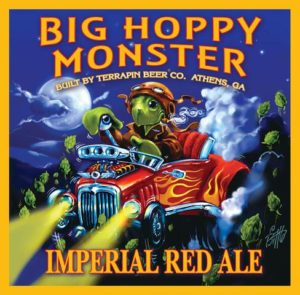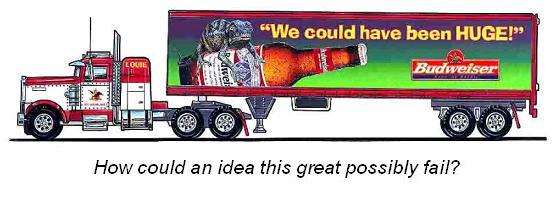Hub-bub. That is what is going on. There is hub-bub afoot these days about “extreme” beer. Here is what I know, though things may be changing on the fly, minute-by-minute as it were:
The Independent in England goes all yikes over BrewDog and other new strong beers even categorizing their article under the “health news” beat. Best ‘fraidy cat panicky quote: “alcohol campaigners have complained that drinkers may be unaware of the strength of the new products, a single 330ml bottle of which is enough to make an adult exceed their daily recommended alcohol intake.” Deary deary. Let’s hope know one in England under 40 has heard of gin either because I understand that, too, can get you tipsy.
Then Pete Brown goes yikey-doodles in response laying it on thick and hearty in return, due to the article’s reliance on his own work to create the “health news” in question. Best Pete-flips-lid quote: “[the article] creates a master class in hypocrisy that would be funny if it wasn’t for the fact that it might damage brewers I care about who spoke to me in good faith.” Look, I know as a good North American I am supposed to think the residents of any EU nation are nothing but big daft socialist softies but I still find it hard to believe that anyone who might actually have chosen to try an extreme beer would be deterred by this “health news” – and suspect, for that matter, that many more would take it as an opportunity to explore the big brews mentioned.
And, then, Stan asks the musical question – with a lot less of the yikes – as to what “extreme beer” actually means to you… and to me. Specifically, he asks:
What I’d like to know is if the term “extreme beer” means something specific to real live beer drinkers. I’ve never heard a customer at a bar say, “I’d like an extreme beer, please.
Good point but since the advent of extreme beers I have also never heard a customer say “I’d like to try a few more of all these wonderful new experimental session beers you offer, good publican.” That’s because extreme beer has had this Vulcan Mind Meld on so many craft brewers that all their explorations are based on turning to the volume to eleven, too often to focus on quantity of taste as opposed to quality. There is no room for modest balance (or modest price for that matter) where all on offer is extreme.
What’s it all mean? My comment at Stan’s begins extreme beer means nothing to me and that is as honest as I can put it. Mainly because it is really nothing new. Experimentation with very strong beers like Samichlaus or Thomas Hardy Ale well predate the X-TR-M label. Experimentation with odd and intense ingredients has been going on in home brewing well before Papazian’s first book. While you are at it, just consider the simple fact of Belgian brewing history or even only the sour branch of it. But besides all that – aside from the claims to new and exciting – for too much of the time extreme beers simply disappoint because they taste like you’ve just sprayed aerosol furniture polish in your mouth or because you really didn’t want to revisit the undergrad skull splitting headache the next day. Yet it has been latched upon as a means to market, to increase price and perhaps forgo value in a way that ignores that the adjective “extreme” has become a bit of a joke in other areas of pop culture.
X3M09? One year later and I still feel now as I did a year ago – the push for more ends up feeling like nothing so much as branding and hyping and inflating of a particularly tedious sort. A little like those ads aimed at “off-centered” people, I really look forward to the day that we look back at “extreme” brewing as we do the song stylings of Rick Astley. Must I quote the Scottish play? Has it come to that? Extreme beers are…
…but a walking shadow, a poor player
That struts and frets his hour upon the stage
And then is heard no more: it is a tale
Told by an idiot, full of sound and fury,
Signifying nothing.
None of which speaks to the quality of any particular beer. Some are wonderful and lovely. But for all the US strong beers I have enjoyed I have disliked more… and more than once felt a bit ripped off. And I suspect most feel this way – though both the panicky health nuts on one hand and the craft marketing hype machine on the other might not like to admit it. The trend is not for death by ale, is not for beer that could sterilize surgical instruments while tasting like steak sauce or shoe leather, is not for the 25 dollar bottle that captures the essence of a thousand hop blossoms. And, because of that, it does a disservice to the bulk of more moderate craft beers and the vast majority of beer sales and buyers.
Were there that North American beer consumer lobbying group, I would expect that a backlash against the focus on extreme might have started some time ago. But we have none so it’s not begun. Maybe it should.
 What to call these beers? For the last few years, brewers have been getting together to make something new together. This one has a deeperback story than most but the point is the same. In the end they are joint projects, opportunities to get together, to share and learn. And no doubt to have a lot of fun. But what do they offer us, the consumer? They are the specials of the specials. The seasonals with only one season. Yet surely they have to stand up for themselves as beer and not be the wall hanging commemorative china plate of the beer world. What can I learn from just this bottle?
What to call these beers? For the last few years, brewers have been getting together to make something new together. This one has a deeperback story than most but the point is the same. In the end they are joint projects, opportunities to get together, to share and learn. And no doubt to have a lot of fun. But what do they offer us, the consumer? They are the specials of the specials. The seasonals with only one season. Yet surely they have to stand up for themselves as beer and not be the wall hanging commemorative china plate of the beer world. What can I learn from just this bottle?








 Have a thought for Saint Patrick, the actual guy. Taken as
Have a thought for Saint Patrick, the actual guy. Taken as  My mid-west beer territory has expanded care of Stan’s visit the other day. The New Glarus Spotted Cow
My mid-west beer territory has expanded care of Stan’s visit the other day. The New Glarus Spotted Cow